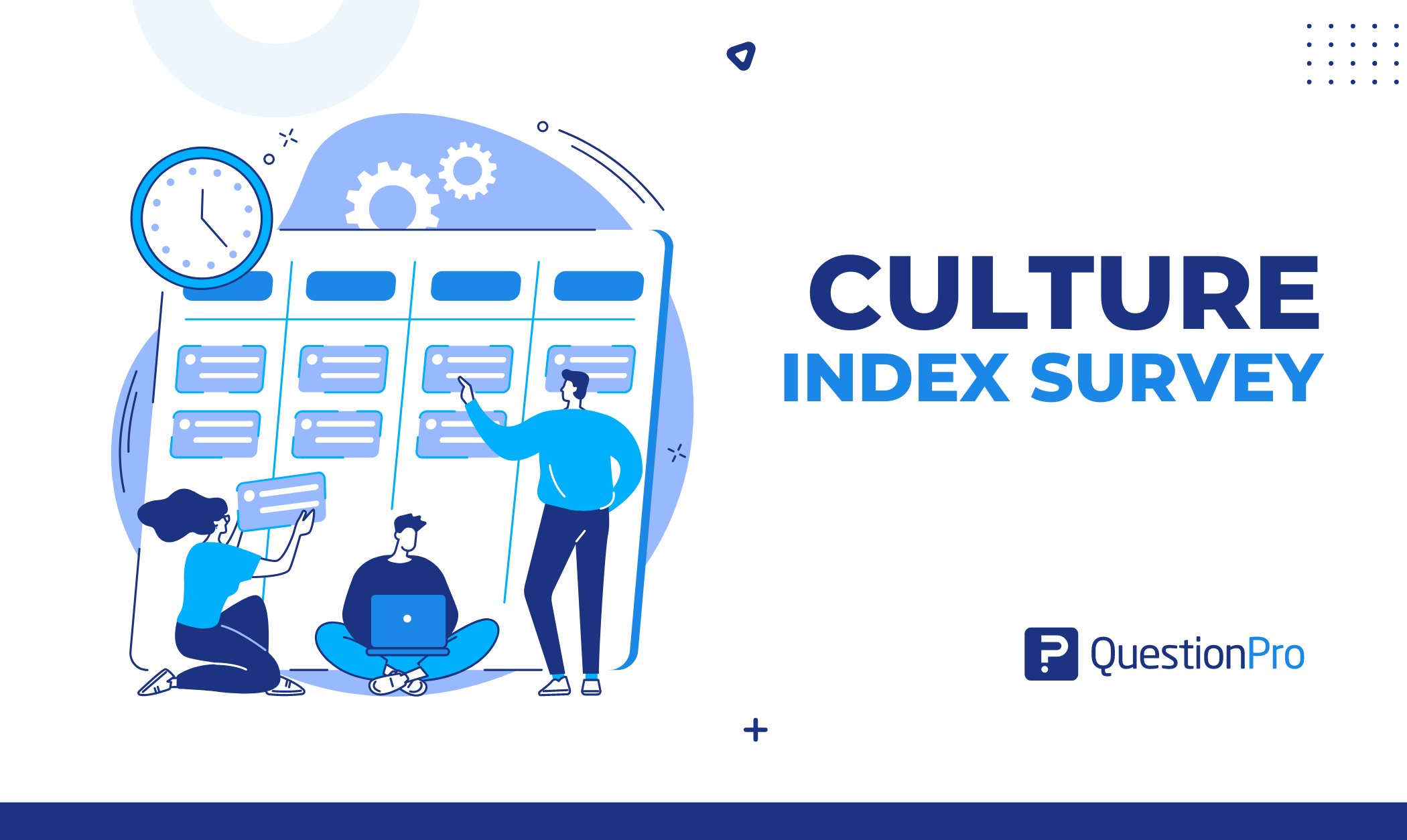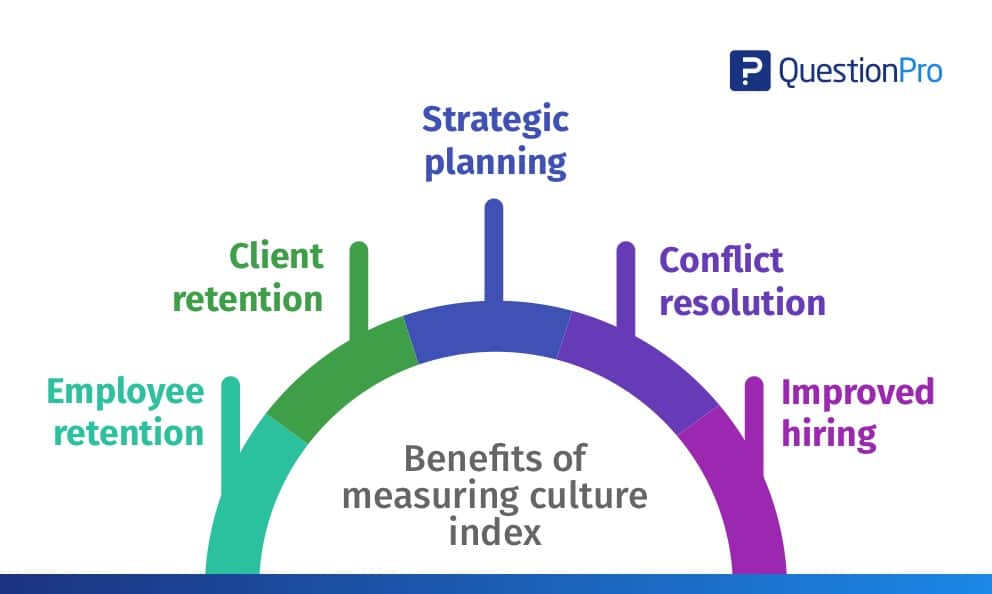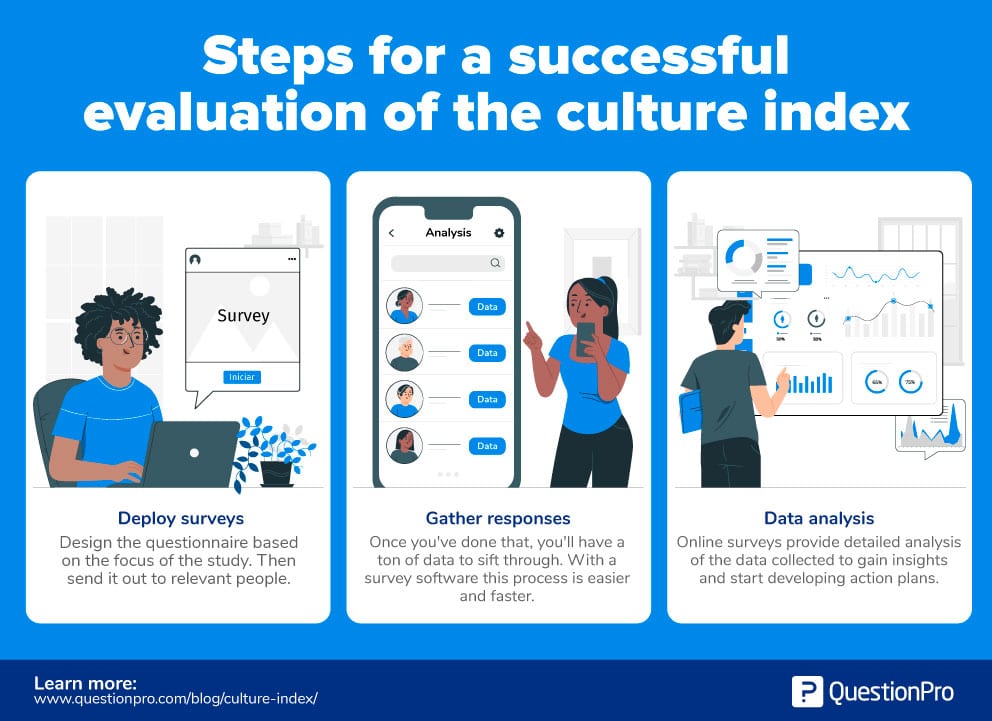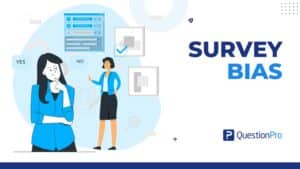
Imagine working in an environment where everyone is inspired to give their all, feels appreciated, and is engaged. How do you measure the pulse of such an environment? The Culture Index Survey is a potent instrument that surpasses conventional techniques for gathering employee input.
Understanding these relationships is essential for your workplace culture and can make or break employee retention and productivity. It gives a clear picture of your company’s state by encapsulating your personnel’s thoughts, feelings, and attitudes.
In this blog, we will explore the definition of a Culture Index Survey, its importance, and how it might improve your company.
What is the Culture Index?
A culture index represents how your workforce feels about being employed. This includes their sentiments, opinions, and attitudes about the different attributes of their roles and responsibilities.
An organization hires employees at different levels. Typically, managers are hired to strategize the overall functioning of their respective teams and maintain the workplace climate. They are responsible for helping their team and ensuring its smooth functioning.
When an organization wants to know how its employees feel, it deploys an employee survey if it has to survey the entire organization. If it’s only a few members, it relies on the managers for a first-hand report.
The index might suggest that something needs to be fixed with the organization. For example, employees are disengaged because they don’t receive enough manager feedback. Lack of feedback translates into low levels of inspiration and employee engagement.
Why Culture Index Is So Important?
The power of a Culture Index Survey to identify the fundamental elements influencing your company’s performance is what makes it so important. Here’s why it matters:
Let’s imagine two organizations: A and B.
Organization A has exceptionally high employee turnover, a low employee Net Promoter Score, and low levels of engagement. This has increased both the product and human resources costs. Most team members are new and have no idea what is happening.
On the contrary, there is organization B that has no such problems. Instead, employees in this organization enjoy coming to work, are highly motivated, take responsibility for the tasks assigned to them, and are proactive.
What makes Organization B stand out? What do you think they are doing right to retain their top talents? How are they engaging their employees? Why are the employees happier than in organization A? The reasons can be many and well-distinguished, but what always stands out is workplace culture.
Ultimately, an organization’s culture makes all the difference. Organizations with a good culture experience lower attrition, higher levels of engagement, and employees who take ownership.
According to a study conducted by Columbia University, the turnover rate is approximately 13.9% for organizations with higher levels of satisfaction, compared to 48.4% for those without!
Happier employees also keep it ringing at the cash counter. According to a study by the University of Warwick, happier employees contribute 12% more than the average employees. Hence, a positive and strong workplace culture is essential.
What is a Culture Index Survey?
A Culture Index Survey is like a mirror reflecting the soul of your organization. It’s a tool that measures how your employees truly feel about their roles, responsibilities, and overall work environment. Beyond job satisfaction, it digs deep into their attitudes, opinions, and emotional connection to the workplace.
Think of it as a heartbeat monitor for your company’s culture, revealing what excites your team, what drains them, and what motivates them to stay or leave. It’s your compass for understanding your workforce’s mindset, helping you create a thriving culture where everyone feels valued and inspired.
How to Conduct a Culture Index Survey
Conducting a Culture Index Survey might sound daunting, but it can be an enlightening experience for your organization. Here’s how to make the process engaging and effective, ensuring everyone’s voice is heard.
Step 1: Define Your Goals
Before starting the survey, clarify what you want to achieve.
- Are you looking to enhance employee engagement?
- Identify areas for improvement? or
- Measure overall satisfaction?
Setting clear objectives will guide your survey design and help you focus on the most important issues.
Step 2: Craft Thoughtful Questions
Now comes the creative part, which is designing the survey! Use a mix of question types:
- Scale ratings,
- Multiple-choice and
- Open-ended questions.
This variety will encourage honest and nuanced responses. Keep questions clear and concise, ensuring they resonate with your team’s experiences. Consider involving a few employees in the design process to get their insights and ensure the questions hit home.
Step 3: Choose the Right Platform
And then, select an online survey tool that fits your needs. Look for user-friendly platforms that offer in-depth analytics and support for multiple responses. This will simplify data collection and make it easier to track trends over time.
Step 4: Communicate and Roll Out
Communication is always the key. Announce the survey across your organization, emphasizing its importance and the anonymity of responses. Encourage participation by explaining how their feedback will lead to meaningful change.
Step 5: Analyze and Act
Once the responses are in, roll up your sleeves and dig into the data. Look for trends, patterns, and areas needing attention. Don’t just collect the information, but transform it into actionable insights! Share the results with your team, and outline steps you’ll take based on their feedback.
By following these steps, you’ll conduct a successful Culture Index Survey and foster a culture of open communication and continuous improvement within your organization.
Implementing a Culture Index Survey
Employee surveys help leadership and HR managers by providing data that lets them know how their employee processes are going. This data empowers them to make informed decisions. Before conducting employee surveys, kindly consider the points below.
Culture Index survey tool
Using an online survey platform or software to measure your organization’s culture index is a good start. These multipurpose, user-friendly tools provide in-depth analytics and support massive surveys and responses. You can assign a frequency, decide on the types of surveys based on your needs and requirements, and start conducting surveys.
Culture Index Survey Program
Organizations conducting employee surveys enjoy high employee engagement, productivity, retention, and morale. It is a good idea to design a survey program before implementing it to have a plan to stick to. To conduct a successful culture index assessment, follow the below steps.
- Deploy surveys: Define the survey’s focus; you will design the questionnaire based on that. Once the questionnaire is ready, you can send it to relevant people. With online survey platforms, you can select the type and number of employees you want to send to their job titles, departments, etc.
- Gather responses: Conducting surveys is just the first step. Once you’ve done that, you will have much data to peruse. You must examine all the data and use it to examine your current processes, revamp them, and launch new ones.
- Data analysis: Online survey tools provide a detailed analysis of your surveys and the data gathered from them. You can view trends over time to see what’s worked or not. Question Workforce’s ‘Trends‘ widget lets you track, analyze, and measure survey measures over time.
You can calculate the employee net promoter score (eNPS) using that. It lets you know about employee loyalty and whether your employees will recommend your organization to their loved ones. It enables you to assign role-based access to the managers that you select. You can use this data to start developing action plans.
Culture index assessment
The culture index assessment helps gather data and identify gaps in employee retention strategy, strategic planning, employee recruitment, training and development, and conflict resolution. Engaged employees stay longer with organizations, make a discretionary effort, are excellent advocates, and are better team players. The assessment helps determine how engaged employees are and their intent to stay.
What are the benefits of measuring culture index?
Since the culture index truly represents how employees feel about working in the organization, it brings many aspects to the fore. Some of these might not be known but surely need attention. Many elements highlight the necessary changes to improve your work culture and employee processes.
Here are the top 5 reasons why the culture index is important:

1. Better employee retention
Organizations with a good culture often see a higher retention rate. Employees go above and beyond to get things done and ensure the organization achieves its goals. So, if employees are happier and there is enthusiasm in the air, the culture index will help analyze your organization’s level of happiness.
2. Client retention
Happy employees mean happy customers. Happy customers keep returning to you for products, services, or both. So, customer retention is essential for any company’s economic growth.
Acquiring a new customer requires a lot of time, resources, and finance. Therefore, customer retention is the key, and your employees can ensure that.
3. Strategic planning
Strategic planning helps an organization implement its ideas into reality. However, it can only be implemented if employees are in sync with what is happening in the organization.
4. Conflict resolution
Whatever the nature of the conflict is, organizations should focus on resolving it. Whether between employees or between employees and customers, organizations should look at conflict resolution as the key to improving the overall environment at work.
When conflict resolution becomes integral to organizational behavior, employees tend to be happy and believe more in top-level management.
5. Improve your hiring
A culture index helps identify what role is best suited for which employee.
- Are they happy with the responsibilities?
- Are they doing justice to the role?
Once you have that data and start analyzing it, you can make informed decisions to hire the right people in the right role. This reduces employee attrition and improves staff productivity and workforce engagement.
Employees are your best advocates. If they appreciate your hiring practices, they will help you hire talent through positive word of mouth.
How QuestionPro Workforce Can Contribute to Culture Index Survey
A powerful tool that can greatly improve your company’s culture index survey by expediting the procedure and offering helpful information is QuestionPro Workforce. This is how it can help:
Customizable Survey Design
With QuestionPro, you can easily create surveys that fit your organization’s unique needs. You can focus on employee engagement and company values, ensuring the survey reflects your goals with a user-friendly drag-and-drop interface.
Advanced Analytics and Reporting
QuestionPro provides detailed analytics, allowing you to track trends and gather insights over time. Leaders can quickly spot patterns to improve their workplace culture and make informed decisions with clear, real-time reports with the help of QuestionPro.
Employee Net Promoter Score (eNPS) Integration
This eNPS feature lets you measure employee loyalty and see how likely they are to recommend your organization. By monitoring eNPS, you can better understand employee satisfaction and identify areas for improvement.
Automated Survey Distribution
The platform automates survey distribution, letting you schedule them for the best times and target specific groups based on job titles or departments. This ensures your surveys reach the right people effectively.
Role-Based Access Control
QuestionPro allows managers to access specific survey data relevant to their teams. This targeted access helps create customized action plans, promoting a culture of ongoing improvement within departments.
Using QuestionPro Workforce for your culture index survey expedites the procedure and gives you the necessary resources to implement significant organizational changes.
Conclusion
In the end, organizational culture goes beyond ping-pong tables and casual Fridays. Find new ways to motivate your employees. The least you can do is provide them with a good work environment.
The culture index will provide the information needed to understand your workforce’s thoughts and reactions. It helps an organization stay on the right path and maneuver the right course of action, ultimately leading to greater success.
QuestionPro Workforce aids HR managers’ efforts and lets them monitor and measure workforce engagement, productivity, etc. Try the platform; it’s simple and super easy to use.








